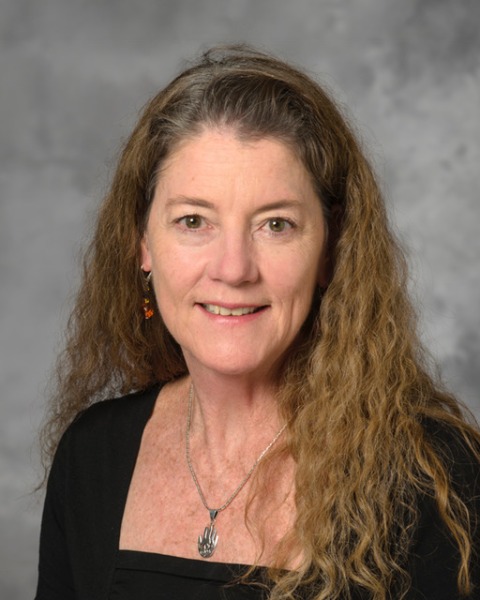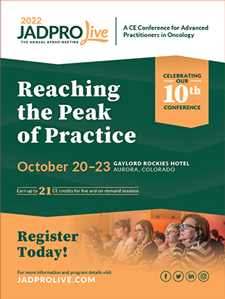Back


Clinical Posters
JL1005C: Building Best Practice for Oral Antineoplastic Therapy Programs: A Model for Multisite, Advanced Practitioner–Led, Quality Care Initiatives
Saturday, October 22, 2022
10:00 AM – 11:00 AM ET

Has Audio

Sandra E. Kurtin, PhD, ANP-C, AOCN®, FAPO (she/her/hers)
Director Advanced Practice, Nurse Practitioner, Clinical Assistant Professor of Medicine
The University of Arizona Cancer Center
Tucson, Arizona, United States
Poster Presenter(s)
BACKGROUND
Advanced Practitioners (APs) are poised to serve as agents of change for practice transformation, including leading the development and clinical integration of and oral antineoplastic agent program (OAP). Practices across the United States have variable levels of OAPs, some with no structured elements, and others with established programs. However, the variability in the structure and success of OAPs presents an opportunity to employ a practice analysis process and early proposal for best practice.
PROGRAM OBJECTIVES
This multi-site AP-led quality of care/improvement (QI) initiative was aimed at developing an APSHO-led practice transformation initiative with APs serving in a site lead role and as the primary agent of change in conducting a practice analysis using an OAP Blueprint to identify opportunities and barriers in developing or optimizing an OAP.
METHODS
A site selection survey was deployed to 10 hematology/oncology practices with AP leads identified by the project core group as meeting eligibility criteria: 1) AP is APSHO, 2) site AP Leads represent a diversity of AP roles, 3) sites representative of range of hematology/oncology practices, 4) administrative support for program participation over a 6-month period, and 5) AP commitment to act as an agent of change in their practice for this project
The Plan-Do-Study-Act (PDSA) Methodology was used to guide this quality initiative using an iterative cyclic method, continuous data collection, and project adaptation based on analysis of each PDSA phase, and a theoretical foundation of evidence-based practice.
This project was granted IRB Exempt status by the WCG IRB on May 13, 2022. APSHO is registered with WCG IRB as a study sponsor.
RESULTS
Five hematology/oncology practices, representing community and academic centers were selected to participate in this project and represent the multi-site working group (WG). Monthly WG meetings and ad-hoc project lead and site lead 1:1 meetings were held using the PDSA methodology to identify priorities. In addition, development of a TEAMs site for sharing of minutes, review of taped meetings, and sharing resources provided an infrastructure for this project.
Within the first 4 months of the project, site leads were able to conduct an initial practice analysis using the OAP Blueprint. Identification of key stakeholders, analysis of existing OAP processes, identification of barriers to implementation, and analysis of the documentation of the OAP process in the Electronic Health Record (EHR) have been summarized by each practice. The most common barriers identified by site leads for conducting the practice analysis included: 1) Time within my own schedule, 2) Availability/time for key stakeholders, 3) Staffing shortages: nursing, 4) Staffing shortages: providers, 5) Competing priorities: professional and 6) Competing priorities: professional. Each site lead identified practice specific gaps, the most important change to be made in their individual practice, opportunities to improve documentation for the OAP process, and ranked stakeholders critical to implementation of or optimization of an OAP process. Individual practice profiles and initial OAP workflows have been developed. All site leads expressed optimism in being able to implement these changes in phase 2 of the project.
CONCLUSIONS
Establishment of a APSHO Project Core Team (December 2021), Steering Committee (April 2022), and Project Working Group (May 2022) has successfully provided a foundation for an APSHO supported multi-site QI project focused on practice analysis and optimization for OAPs. Phase 2 of this project will focus on implementation of changes identified in the practice analysis and recommendation for best practice for OAPs.
RECOMMENDATIONS
This innovative IRB approved project provides a model for future multi-site initiatives sponsored by APSHO and implemented by a representative group of AP experts and practices.
Advanced Practitioners (APs) are poised to serve as agents of change for practice transformation, including leading the development and clinical integration of and oral antineoplastic agent program (OAP). Practices across the United States have variable levels of OAPs, some with no structured elements, and others with established programs. However, the variability in the structure and success of OAPs presents an opportunity to employ a practice analysis process and early proposal for best practice.
PROGRAM OBJECTIVES
This multi-site AP-led quality of care/improvement (QI) initiative was aimed at developing an APSHO-led practice transformation initiative with APs serving in a site lead role and as the primary agent of change in conducting a practice analysis using an OAP Blueprint to identify opportunities and barriers in developing or optimizing an OAP.
METHODS
A site selection survey was deployed to 10 hematology/oncology practices with AP leads identified by the project core group as meeting eligibility criteria: 1) AP is APSHO, 2) site AP Leads represent a diversity of AP roles, 3) sites representative of range of hematology/oncology practices, 4) administrative support for program participation over a 6-month period, and 5) AP commitment to act as an agent of change in their practice for this project
The Plan-Do-Study-Act (PDSA) Methodology was used to guide this quality initiative using an iterative cyclic method, continuous data collection, and project adaptation based on analysis of each PDSA phase, and a theoretical foundation of evidence-based practice.
This project was granted IRB Exempt status by the WCG IRB on May 13, 2022. APSHO is registered with WCG IRB as a study sponsor.
RESULTS
Five hematology/oncology practices, representing community and academic centers were selected to participate in this project and represent the multi-site working group (WG). Monthly WG meetings and ad-hoc project lead and site lead 1:1 meetings were held using the PDSA methodology to identify priorities. In addition, development of a TEAMs site for sharing of minutes, review of taped meetings, and sharing resources provided an infrastructure for this project.
Within the first 4 months of the project, site leads were able to conduct an initial practice analysis using the OAP Blueprint. Identification of key stakeholders, analysis of existing OAP processes, identification of barriers to implementation, and analysis of the documentation of the OAP process in the Electronic Health Record (EHR) have been summarized by each practice. The most common barriers identified by site leads for conducting the practice analysis included: 1) Time within my own schedule, 2) Availability/time for key stakeholders, 3) Staffing shortages: nursing, 4) Staffing shortages: providers, 5) Competing priorities: professional and 6) Competing priorities: professional. Each site lead identified practice specific gaps, the most important change to be made in their individual practice, opportunities to improve documentation for the OAP process, and ranked stakeholders critical to implementation of or optimization of an OAP process. Individual practice profiles and initial OAP workflows have been developed. All site leads expressed optimism in being able to implement these changes in phase 2 of the project.
CONCLUSIONS
Establishment of a APSHO Project Core Team (December 2021), Steering Committee (April 2022), and Project Working Group (May 2022) has successfully provided a foundation for an APSHO supported multi-site QI project focused on practice analysis and optimization for OAPs. Phase 2 of this project will focus on implementation of changes identified in the practice analysis and recommendation for best practice for OAPs.
RECOMMENDATIONS
This innovative IRB approved project provides a model for future multi-site initiatives sponsored by APSHO and implemented by a representative group of AP experts and practices.

